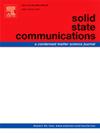关于γ-InSe 层状半导体室温持续光电导性的研究
IF 2.1
4区 物理与天体物理
Q3 PHYSICS, CONDENSED MATTER
引用次数: 0
摘要
我们介绍了γ-InSe 层状半导体中的室温持续光电导效应(PPC)。从室温到 200 K 的温度范围内都能观察到 PPC 效应,并且 PPC 的衰变可以用拉伸指数函数很好地描述。随温度变化的PPC和PPC衰变的性能表明,随机局部电位波动(RLPF)机制是γ-InSe中PPC效应的原因。此外,与 RLPF 机制相关的渗流模型可以很好地解释不同温度区域的 PPC 行为。本文章由计算机程序翻译,如有差异,请以英文原文为准。
Investigation on room-temperature persistent photoconductivity in γ-InSe layered semiconductor
We have presented the room-temperature persistent photoconductivity (PPC) effect in γ-InSe layered semiconductors. The PPC effect can be observed in the temperature range from room temperature down to 200 K, and the PPC decay is well described by a stretch-exponential function. The temperature-dependent PPC and performance of PPC decay indicate that the random local-potential fluctuations (RLPF) mechanism is responsible for PPC effect inγ-InSe. In addition, the PPC behavior at different temperature regions can be well explained by the percolation model associated with the RLPF mechanism.
求助全文
通过发布文献求助,成功后即可免费获取论文全文。
去求助
来源期刊

Solid State Communications
物理-物理:凝聚态物理
CiteScore
3.40
自引率
4.80%
发文量
287
审稿时长
51 days
期刊介绍:
Solid State Communications is an international medium for the publication of short communications and original research articles on significant developments in condensed matter science, giving scientists immediate access to important, recently completed work. The journal publishes original experimental and theoretical research on the physical and chemical properties of solids and other condensed systems and also on their preparation. The submission of manuscripts reporting research on the basic physics of materials science and devices, as well as of state-of-the-art microstructures and nanostructures, is encouraged.
A coherent quantitative treatment emphasizing new physics is expected rather than a simple accumulation of experimental data. Consistent with these aims, the short communications should be kept concise and short, usually not longer than six printed pages. The number of figures and tables should also be kept to a minimum. Solid State Communications now also welcomes original research articles without length restrictions.
The Fast-Track section of Solid State Communications is the venue for very rapid publication of short communications on significant developments in condensed matter science. The goal is to offer the broad condensed matter community quick and immediate access to publish recently completed papers in research areas that are rapidly evolving and in which there are developments with great potential impact.
 求助内容:
求助内容: 应助结果提醒方式:
应助结果提醒方式:


